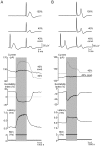GABA increases electrical excitability in a subset of human unmyelinated peripheral axons
- PMID: 20098693
- PMCID: PMC2808338
- DOI: 10.1371/journal.pone.0008780
GABA increases electrical excitability in a subset of human unmyelinated peripheral axons
Abstract
Background: A proportion of small diameter primary sensory neurones innervating human skin are chemosensitive. They respond in a receptor dependent manner to chemical mediators of inflammation as well as naturally occurring algogens, thermogens and pruritogens. The neurotransmitter GABA is interesting in this respect because in animal models of neuropathic pain GABA pre-synaptically regulates nociceptive input to the spinal cord. However, the effect of GABA on human peripheral unmyelinated axons has not been established.
Methodology/principal findings: Electrical stimulation was used to assess the effect of GABA on the electrical excitability of unmyelinated axons in isolated fascicles of human sural nerve. GABA (0.1-100 microM) increased electrical excitability in a subset (ca. 40%) of C-fibres in human sural nerve fascicles suggesting that axonal GABA sensitivity is selectively restricted to a sub-population of human unmyelinated axons. The effects of GABA were mediated by GABA(A) receptors, being mimicked by bath application of the GABA(A) agonist muscimol (0.1-30 microM) while the GABA(B) agonist baclofen (10-30 microM) was without effect. Increases in excitability produced by GABA (10-30 microM) were blocked by the GABA(A) antagonists gabazine (10-20 microM), bicuculline (10-20 microM) and picrotoxin (10-20 microM).
Conclusions/significance: Functional GABA(A) receptors are present on a subset of unmyelinated primary afferents in humans and their activation depolarizes these axons, an effect likely due to an elevated intra-axonal chloride concentration. GABA(A) receptor modulation may therefore regulate segmental and peripheral components of nociception.
Conflict of interest statement
Figures





Similar articles
-
Axonal GABAA stabilizes excitability in unmyelinated sensory axons secondary to NKCC1 activity.J Physiol. 2021 Sep;599(17):4065-4084. doi: 10.1113/JP279664. Epub 2021 Jul 29. J Physiol. 2021. PMID: 34174096
-
GABAA receptor-mediated excitation of nociceptive afferents in the rat isolated spinal cord-tail preparation.Neuropharmacology. 1994 Jan;33(1):109-14. doi: 10.1016/0028-3908(94)90104-x. Neuropharmacology. 1994. PMID: 8183434
-
Enteric GABA-containing nerves projecting to the guinea-pig inferior mesenteric ganglion modulate acetylcholine release.J Physiol. 1993 Nov;471:191-207. doi: 10.1113/jphysiol.1993.sp019897. J Physiol. 1993. PMID: 8120803 Free PMC article.
-
Involvement of GABA systems in feedback regulation of glutamate-and GABA-mediated synaptic potentials in rat neostriatum.J Physiol. 1991;440:581-99. doi: 10.1113/jphysiol.1991.sp018726. J Physiol. 1991. PMID: 1666654 Free PMC article.
-
Sensitivities of Achatina giant neurones to putative amino acid neurotransmitters.Comp Biochem Physiol C Comp Pharmacol Toxicol. 1992 Sep;103(1):1-12. doi: 10.1016/0742-8413(92)90219-w. Comp Biochem Physiol C Comp Pharmacol Toxicol. 1992. PMID: 1360362 Review.
Cited by
-
Estrogen receptors observed at extranuclear neuronal sites and in glia in the nucleus accumbens core and shell of the female rat: Evidence for localization to catecholaminergic and GABAergic neurons.J Comp Neurol. 2022 Aug;530(11):2056-2072. doi: 10.1002/cne.25320. Epub 2022 Apr 9. J Comp Neurol. 2022. PMID: 35397175 Free PMC article.
-
Beyond faithful conduction: short-term dynamics, neuromodulation, and long-term regulation of spike propagation in the axon.Prog Neurobiol. 2011 Sep 1;94(4):307-46. doi: 10.1016/j.pneurobio.2011.06.001. Epub 2011 Jun 17. Prog Neurobiol. 2011. PMID: 21708220 Free PMC article. Review.
-
Neuronal activity in the hub of extrasynaptic Schwann cell-axon interactions.Front Cell Neurosci. 2013 Nov 25;7:228. doi: 10.3389/fncel.2013.00228. eCollection 2013. Front Cell Neurosci. 2013. PMID: 24324401 Free PMC article.
-
Sodium Channel Nav1.8 Underlies TTX-Resistant Axonal Action Potential Conduction in Somatosensory C-Fibers of Distal Cutaneous Nerves.J Neurosci. 2017 May 17;37(20):5204-5214. doi: 10.1523/JNEUROSCI.3799-16.2017. Epub 2017 Apr 27. J Neurosci. 2017. PMID: 28450535 Free PMC article.
-
Etomidate and propylene glycol activate nociceptive TRP ion channels.Mol Pain. 2018 Jan-Dec;14:1744806918811699. doi: 10.1177/1744806918811699. Epub 2018 Oct 22. Mol Pain. 2018. PMID: 30345869 Free PMC article.
References
-
- Brown DA. Extrasynaptic GABA systems. TINS. 1979;2:271–273.
-
- Farrant M, Nusser Z. Variations on an inhibitory theme: phasic and tonic activation of GABA(A) receptors. Nat Rev Neurosci. 2005;6:215–229. - PubMed
-
- Semyanov A, Walker MC, Kullmann DM, Silver RA. Tonically active GABA A receptors: modulating gain and maintaining the tone. Trends Neurosci. 2004;27:262–269. - PubMed
-
- Valeyev AY, Hackman JC, Wood PM, Davidoff RA. Pharmacologically novel GABA receptor in human dorsal root ganglion neurons. J Neurophysiol. 1996;76:3555–3558. - PubMed
-
- Valeyev AY, Hackman JC, Holohean AM, Wood PM, Katz JL, Davidoff RA. GABA-Induced Cl− current in cultured embryonic human dorsal root ganglion neurons. J Neurophysiol. 1999;82:1–9. - PubMed
Publication types
MeSH terms
Substances
LinkOut - more resources
Full Text Sources

